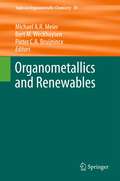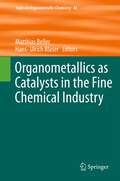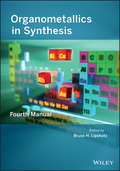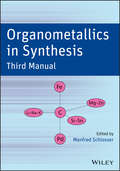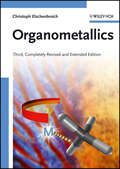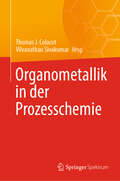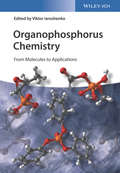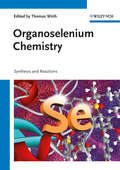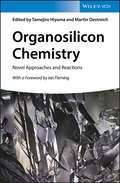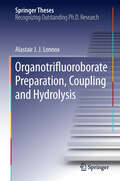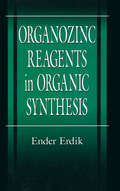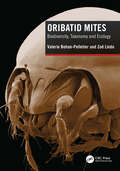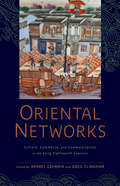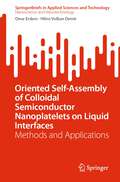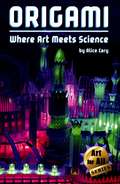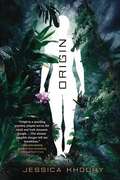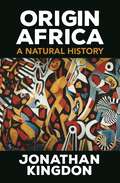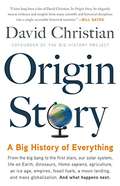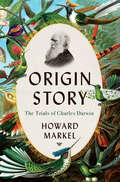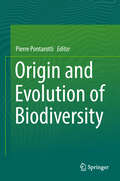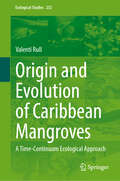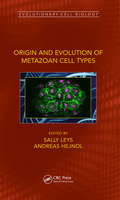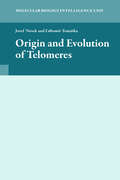- Table View
- List View
Organometallics and Renewables
by Bert M. Weckhuysen Michael A.R. Meier Pieter C. BruijnincxLucas Montero de Espinosa and Michael A. R. Meier: Olefin Metathesis of Renewable Platform Chemicals.- Pieter C. A. Bruijnincx, Robin Jastrzebski, Peter J. C. Hausoul, Robertus J. M. Klein Gebbink, and Bert M. Weckhuysen: Pd-Catalysed Telomerisation of 1,3-Dienes with Multifunctional Renewable Substrates - Versatile Routes for the Valorisation of Biomass-Derived Platform Molecules.- A Behr, A. J. Vorholt: Hydroformylation and related reactions of renewable resources.- Ties J. Korstanje, Robertus J.M. Klein Gebbink: Catalytic oxidation and deoxygenation of renewables with rhenium complexes.- Antoine Buchard, Clare M. Bakewell, Jonathan Weiner and Charlotte K. Williams: Recent Developments In Catalytic Activation Of Renewable Resources For Polymer Synthesis.
Organometallics as Catalysts in the Fine Chemical Industry
by Matthias Beller Hans-Ulrich BlaserJohannes G. de Vries: Pd-catalyzed coupling reactions.- Gregory T. Whiteker and Christopher J. Cobley: Applications of Rhodium-Catalyzed Hydroformylation in the Pharmaceutical, Agrochemical and Fragrance Industries.- Philippe Dupau: Ruthenium-catalyzed Selective Hydrogenation for Flavor and Fragrance Applications.- Hans-Ulrich Blaser, Benoît Pugin and Felix Spindler: Asymmetric Hydrogenation.- Ioannis Houpis: Case Study: Sequential Pd-catalyzed Cross-Coupling Reactions; Challenges on Scale-up.- Adriano F. Indolese: Pilot Plant Scale Synthesis of an Aryl-Indole - Scale up of a Suzuki Coupling.- Per Ryberg: Development of a Mild and Robust Method for Palladium Catalysed Cyanation on Large Scale.- Cheng-yi Chen: Application of Ring Closing Metathesis Strategy to the Synthesis of Vaniprevir (MK-7009), a 20-Membered Macrocyclic HCV Protease Inhibitor.
Organometallics in Process Chemistry (Topics in Organometallic Chemistry #65)
by Thomas J. Colacot Vilvanathan SivakumarThis volume gives an overview of the applications of organometallic chemistry in process chemistry relevant to the current topics in synthetic chemistry. This volume starts with an introduction on the historical development of organometallics in process chemistry and is followed by chapters dealing with the last five years’ development in various organometallic reaction types such as the challenging cross coupling process, construction of 3.1.0 bicycles, pressure and transfer hydrogenations of historically challenging compounds such as esters, utilization of carbon dioxide for making organic compounds by flow process, drug synthesis and metal detection and scavenging in the finished APIs. A chapter by Colacot et.al., is also devoted to the process development and structural understanding of organometallic catalysts with particular emphasis to LnPd(0) catalysts. An academia – industry collaborated chapter on the use of water as a solvent for organometallic processes is included in this book.
Organometallics in Synthesis
by Bruce H. LipshutzProvides detailed procedures and useful hints on organometallic reactions of Cu, Rh, Ni, and AuWith contributions from leading organic chemists who specialize in the use of organometallics in organic synthesis, this acclaimed Manual offers an especially valuable resource for all synthetic chemists, providing a practical reference for conducting transition metal-mediated synthetic reactions. This Fourth Manual is divided into four chapters:Chapter I: Organocopper ChemistryChapter II: Organorhodium ChemistryChapter III: Organonickel ChemistryChapter IV: Organogold ChemistryEach of these newly written chapters features detailed, practical examples from the literature that guide readers through the preparation of organometallic reagents and their applications in organic synthesis. Procedures are presented in the Manual's acclaimed step-by-step recipe format, enabling both novices and experienced synthetic chemists to perform all the reactions with ease. In addition, the Manual features:Extensive background information on the organometallic chemistry of Cu, Rh, Ni, and AuReferences to the primary literature facilitating further investigation of all the reactions covered in the ManualMechanistic considerations to help readers better understand how the desired products are formedFuture research opportunities for each organometallic classOrganometallics in Synthesis provides extensive and detailed information enabling synthetic chemists to readily assess the applicability of a synthetic method to a given need, and then to perform the reaction with confidence. The Manual covers both established organometallic procedures along with the most recently published protocols.Industrial processes are increasingly relying on organometallic chemistry. In this Manual, readers will find applications to such fields as natural products total synthesis, pharmaceuticals, fine chemicals, biotechnology, agricultural science, polymers, and materials science.
Organometallics in Synthesis, Third Manual
by Manfred SchlosserWINNER of the 2013 PROSE Award in Chemistry & PhysicsThis latest edition enables readers to master new classes of organometallic compounds and synthesesA popular resource used by synthetic organic chemists around the world, this book enables readers to conduct seamless synthetic reactions involving key organometallics. Each reaction is set forth in the book's acclaimed recipe-style format so that readers can easily replicate the results in their own labs. Moreover, each chapter has been written by a world leader in the field of organometallics in organic synthesis. These authors offer hands-on guidance and practical examples illustrating the preparation of organometallics and its application in organic synthesis.This Third Manual of Organometallics in Synthesis features completely new content and topics, with an eye towards providing researchers with the most useful and practical reference on the synthesis of organometallics. Organized into chapters by type of organometallic compound, the book covers:Organoalkali chemistryOrganomagnesium and organozinc chemistryOrganosilicon and relating organotin chemistryOrganoiron chemistryOrganopalladium chemistryWithin each chapter, readers will find background information to learn more about the class of organometallics as well as mechanistic considerations. The authors thoroughly discuss the various methods of preparing the organometallic compounds presented in the book and outline their uses in synthetic reactions. In addition to current applications, the authors explore future research opportunities for each organometallic class. References at the end of each chapter enable readers to explore all the topics in greater depth.More and more industrial processes rely on organometallic chemistry. As a result, readers will find this book's step-by-step instructions essential in such fields as natural product synthesis, pharmaceuticals, fine chemicals, biotechnology, polymers, and materials science.
Organometallics: A Concise Introduction
by Christoph ElschenbroichTHE textbook on organometallic chemistry. Comprehensive and up-to-date, the German original is already a classic, making this third completely revised and updated English edition a must for graduate students and lecturers in chemistry, inorganic chemists, chemists working with/on organometallics, bioinorganic chemists, complex chemists, and libraries. Over one third of the chapters have been expanded to incorporate developments since the previous editions, while the chapter on organometallic catalysis in synthesis and production appears for the first time in this form. From the reviews of the first English editions: 'The selection of material and the order of its presentation is first class ... Students and their instructors will find this book extraordinarily easy to use and extraordinarily useful.' -Chemistry in Britain 'Elschenbroich and Salzer have written the textbook of choice for graduate or senior-level courses that place an equal emphasis on main group element and transition metal organometallic chemistry. ... this book can be unequivocally recommended to any teacher or student of organometallic chemistry.' - Angewandte Chemie International Edition 'The breadth and depth of coverage are outstanding, and the excitement of synthetic organometallic chemistry comes across very strongly.' - Journal of the American Chemical Society
Organometallik in der Prozesschemie
by Thomas J. Colacot Vilvanathan SivakumarDieser Band gibt einen Überblick über die Anwendungen der metallorganischen Chemie in der Prozesschemie, die für die aktuellen Themen der synthetischen Chemie relevant sind. Der Band beginnt mit einer Einleitung über die historische Entwicklung der Organometallchemie in der Prozesschemie, gefolgt von Kapiteln, die sich mit den Entwicklungen der letzten fünf Jahre bei verschiedenen metallorganischen Reaktionstypen befassen, wie dem anspruchsvollen Kreuzkupplungsprozess, der Konstruktion von 3.1. 0-Fahrrädern, Druck- und Transfer-Hydrierungen von historisch anspruchsvollen Verbindungen wie Estern, der Nutzung von Kohlendioxid für die Herstellung organischer Verbindungen im Durchflussverfahren, der Arzneimittel-Synthese und der Metalldetektion und -reinigung in den fertigen APIs Ein Kapitel von Colacot et.al. ist der Verfahrensentwicklung und dem strukturellen Grundverständnis von metallorganischen Katalysatoren gewidmet, wobei der Schwerpunkt auf LnPd(0)-Katalysatoren liegt Das Buch enthält ein Kapitel über die Verwendung von Wasser als Lösungsmittel für organometallische Prozesse, das in Zusammenarbeit zwischen Wissenschaft und Industrie durchgeführt wurde.
Organophosphorus Chemistry: From Molecules to Applications
by Viktor IaroshenkoFilling the gap for an up-to-date reference that presents the field of organophosphorus chemistry in a comprehensive and clearly structured way, this one-stop source covers the chemistry, properties, and applications from life science and medicine. Divided into two parts, the first presents the chemistry of various phosphorus-containing compounds and their synthesis, including ylides, acids, and heterocycles. The second part then goes on to look at applications in life science and bioorganic chemistry. Last but not least, such important practical aspects as 31P-NMR and protecting strategies for these compounds are presented. <p><p> For organic, bioinorganic, and medicinal chemists, as well as those working on organometallics, and for materials scientists. The book, a contributed work, features a team of renowned scientists from around the world whose expertise spans the many aspects of modern organophosphorus chemistry.
Organophosphorus Pesticides
by Morifusa EtoIn order to get a general concept of organophosphorus pesticides with such a variety in structure and biological activities, consideration of each aspect of chemistry, biochemistry, and the applied sciences is necessary. This book consists of these three main parts. After the presentation of the background of phosphorus chemistry in Chapter 1, stress was put on the chemical and biochemical reactions of organophosphorus pesticides, including synthesis, analysis, metabolism mode of action, and other interesting aspects in Chapter 2 to 4, and on the structure-pesticidal activity relationship in Chapter 5.
Organoselenium Chemistry
by Thomas WirthSelenium-based methods in synthetic chemistry have developed rapidly over the past years and are now offering highly useful tools for organic synthesis. Filling the gap for a comprehensive handbook and ready reference, this book covers all modern developments withinthe field, including biochemical aspects. The chemistry chapters are organized according to the different reactivities of various seleniumcompounds and reagents, with each chapter dealing with a special reaction type. Also includes a table with 77Se NMR shifts to aid in practical problems.From the Contents:* Electrophilic and Nucleophilic Selenium* Selenium Compounds in Radical Reactions* Selenium-Stabilized Carbanions* Selenium Compounds with Valency Higher than Two* Selenocarbonyls* Selenoxide Elimination and [2,3]-Sigmatropic Rearrangement* Selenium Compounds as Ligands and Catalysts* Biological and Biochemical Aspects of Selenium Compounds
Organosilicon Chemistry: Novel Approaches and Reactions
by Martin Oestreich Tamejiro HiyamaProvides a unique summary of important catalytic reactions in the presence of silicon A must-have for all synthetic chemists, this book summarizes all of the important developments in the application of organosilicon compounds in organic synthesis and catalysis. Edited by two world leaders in the field, it describes different approaches and covers a broad range of reactions, e.g. catalytic generation of silicon nucleophiles, Si-H Bond activation, C-H bond silylation, silicon-based cross-coupling reactions, and hydrosilylation in the presence of earth-abundant metals. In addition to the topics covered above, Organosilicon Chemistry: Novel Approaches and Reactions features chapters that look at Lewis base activation of silicon Lewis acids, silylenes as ligands in catalysis, and chiral silicon molecules. -The first book about this topic in decades, covering a broad range of reactions -Covers new approaches and novel catalyst systems that have been developed in recent years -Written by well-known, international experts in the areas of organometallic silicon chemistry and organosilicon cross-coupling reactions Organosilicon Chemistry: Novel Approaches and Reactions is an indispensable source of information for synthetic chemists in academia and industry, working in the field of organic synthesis, catalysis, and main-group chemistry.
Organotrifluoroborate Preparation, Coupling and Hydrolysis
by Alastair J. LennoxAlistair Lennox's thesis reports on the reactivity of organotrifluoroborates, which are becoming increasingly important reagents in synthesis. The thesis is divided into three sections. The first section describes a method for preparing organotrifluoroborates. The second section reports on a mechanistic investigation into the main application of RBF3K reagents as coupling partners in Suzuki-Miyaura coupling, phenomena identified as arising from organotrifluoroborate hydrolysis and fluoride release. The final section reports on a detailed investigation into the hydrolysis mechanism, a prerequisite for their Suzuki-Miyaura coupling, and how it may be predicted and controlled. This research has uncovered many interesting and useful details and shows how problems associated with Suzuki-Miyaura coupling can best be addressed. There has already been wide industrial uptake of the new procedures and insights. The broad nature and clear and succinct style will make the thesis a valuable resource for anyone working in synthesis, organometallic chemistry, or in homogeneous catalysis.
Organozinc Reagents in Organic Synthesis (New Directions In Organic And Biological Chemistry Ser. #9)
by Ender ErdikOrganozinc reagents are used extensively in organic synthesis to find useful pathways to organic products. Illustrated and tabulated with over 950 equations, schemes, tables, and figures, Organozinc Reagents in Organic Synthesis provides an overall picture of the chemistry of organozinc compounds. Written by a professor of organic chemistry, the book familiarizes the reader with the reactions involving organozinc reagents that have general usefulness in synthesis. Emphasis is placed on preparation methods and reactivity of organozinc reagents. Reactions are summarized in equations and schemes, making it easy for you to see the characteristics of each type of reaction.
Oribatid Mites: Biodiversity, Taxonomy and Ecology
by Valerie Behan-Pelletier Zoë LindoOribatid mites, also called beetle or moss mites, include more than 10,000 named species representing 172 families worldwide. This book provides an identification key to the 96 families, 250 genera and the c.580 described species for Canada and Alaska, a fauna that encompasses more than 50% of Northern Hemisphere genera. It includes known data on the ecology of species, their distribution in the Holarctic region, and relevant literature. Oribatid mites are model arthropods in studies on development, morphology, ecology, physiology, and biomechanics. Growing recognition of the importance of soil systems for agriculture, reclamation, carbon storage and climate mitigation has spurred recent interest in the vast soil biodiversity that provide these ecosystem services. Yet the major barrier to exploring and understanding soil biodiversity is lack of comprehensive and functional taxonomic and ecological treatments of key biotic groups; groups such as the oribatid mites. Oribatid Mites is unparalleled in the comprehensive nature of the information provided. The authors, two leading global experts for this group, hope that readers will come to share their understanding of oribatid mites as part of the charismatic microfauna, the imagery in this book conveying their unique beauty.
Oriental Networks: Culture, Commerce, and Communication in the Long Eighteenth Century (Aperçus: Histories Texts Cultures)
by Greg Clingham James Watt Richard Coulton Kevin L. Cope Samara Anne Cahill Bärbel Czennia Stephanie Howard-Smith Jennifer L. HargraveOriental Networks explores forms of interconnectedness between Western and Eastern hemispheres during the long eighteenth century, a period of improving transportation technology, expansion of intercultural contacts, and the emergence of a global economy. In eight case studies and a substantial introduction, the volume examines relationships between individuals and institutions, precursors to modern networks that engaged in forms of intercultural exchange. Addressing the exchange of cultural commodities (plants, animals, and artifacts), cultural practices and ideas, the roles of ambassadors and interlopers, and the literary and artistic representation of networks, networkers, and networking, contributors discuss the effects on people previously separated by vast geographical and cultural distance. Rather than idealizing networks as inherently superior to other forms of organization, Oriental Networks also considers Enlightenment expressions of resistance to networking that inform modern skepticism toward the concept of the global network and its politics. In doing so the volume contributes to the increasingly global understanding of culture and communication. Published by Bucknell University Press. Distributed worldwide by Rutgers University Press.
Oriented Self-Assembly of Colloidal Semiconductor Nanoplatelets on Liquid Interfaces: Methods and Applications (SpringerBriefs in Applied Sciences and Technology)
by Hilmi Volkan Demir Onur ErdemThis book highlights the fabrication of orientation-controlled colloidal quantum well (nanoplatelet) thin films using liquid interface self-assembly. The book details methods for orientation-controlled deposition of CdSe core nanoplatelets for characterization of directional energy transfer in nanoplatelets and layer-by-layer construction of CdSe/CdZnS core/shell nanoplatelets to create optically active waveguides with precisely tunable thickness and excellent uniformity across device scale. It also provides a future outlook for construction of large-scale two- and three-dimensional nanoplatelet superstructures and their incorporation into device fabrication.
Origami: Where Art Meets Science (Fountas & Pinnell LLI Purple #Level V)
by Alice CaryOrigami: Where Art Meets Science by Alice Cary
Origin
by Jessica KhouryPia has always known her destiny. She is meant to start a new race, a line of descendants who will bring an end to death. She has been bred for no other purpose, genetically engineered to be immortal and raised by a team of scientists in a secret compound hidden deep in the Amazon rainforest. Now those scientists have begun to challenge her, with the goal of training her to carry on their dangerous work. For as long as she can remember, Pia's greatest desire has been to fulfill their expectations. But then one night she finds a hole in the impenetrable fence that surrounds her sterile home. Free in the jungle for the first time in her life, Pia meets Eio, a boy from a nearby village. Unable to resist, she continues sneaking out to see him. As they fall in love, they begin to piece together the truth about Pia's origin--a truth with nothing less than deadly consequences that will change their lives forever. Origin is a beautifully told, electric new way to look at an age-old desire: to live forever. But is eternal life worth living if you can't spend it with the one you love?
Origin Africa: A Natural History
by Jonathan KingdonA richly illustrated journey through the evolution of Africa’s extraordinary natural world across deep timeOrigin Africa is a unique introduction to the natural history and evolution of the most misrepresented continent on Earth. Celebrated evolutionary biologist and artist Jonathan Kingdon, a leading expert on the natural history of Africa, tells this extraordinary story as no one else can. Featuring a wealth of photographs and illustrations, the book is both a visual and narrative feast.Africa is the richest continent, containing every habitat from desert to tropical forest and the widest range of plants and animals found anywhere. It has experienced extraordinary climate fluctuations, meteor bombardment, and cataclysmic volcanic eruptions. Yet life has not only survived but evolved almost countless species. One group of primates evolved out of this crucible and moved out of Africa to dominate every continent on Earth. Africa has properties that ensure that most of human evolution couldn’t have occurred anywhere else.A fascinating story told as never before, Origin Africa chronicles how the natural conditions of Africa enabled a spectacular evolution of plants and animals, including Homo sapiens.
Origin Story: A Big History of Everything
by David Christian"I have long been a fan of David Christian. In Origin Story, he elegantly weaves evidence and insights from many scientific and historical disciplines into a single, accessible historical narrative." --Bill GatesA captivating history of the universe -- from before the dawn of time through the far reaches of the distant future.Most historians study the smallest slivers of time, emphasizing specific dates, individuals, and documents. But what would it look like to study the whole of history, from the big bang through the present day -- and even into the remote future? How would looking at the full span of time change the way we perceive the universe, the earth, and our very existence?These were the questions David Christian set out to answer when he created the field of "Big History," the most exciting new approach to understanding where we have been, where we are, and where we are going. In Origin Story, Christian takes readers on a wild ride through the entire 13.8 billion years we've come to know as "history." By focusing on defining events (thresholds), major trends, and profound questions about our origins, Christian exposes the hidden threads that tie everything together -- from the creation of the planet to the advent of agriculture, nuclear war, and beyond.With stunning insights into the origin of the universe, the beginning of life, the emergence of humans, and what the future might bring, Origin Story boldly reframes our place in the cosmos.
Origin Story: The Trials of Charles Darwin
by Howard MarkelA lively account of how Darwin’s work on natural selection transformed science and society, and an investigation into the mysterious illness that plagued its author. By early morning of June 30, 1860, a large crowd began to congregate in front of Oxford University’s brand-new Museum of Natural History. The occasion was the annual meeting of the British Association for the Advancement of Science, and the subject of discussion was Charles Darwin’s new treatise: fact or fiction? Darwin, a simultaneously reclusive and intellectually audacious squire from Kent, claimed to have solved “that mystery of mysteries,” introducing a logical explanation of the origin of species—how they adapted, even transmogrified, through natural selection. At stake, on that summer’s day of spirited debate, was the very foundation of modern biology, not to mention the future of the church. Without fear of exaggeration, Darwin’s thesis would forever change our understanding of the life sciences and the natural world. And yet the author himself was nowhere to be found in the debate hall—instead, he was miles away, seeking respite from a spate of illnesses that had plagued him for much of his adult life. In Origin Story, medical historian Howard Markel recounts the two-year period (1858 to 1860) of Darwin’s writing of On the Origin of Species through its spectacular success and controversy. Simultaneously, Markel delves into the mysterious health symptoms Darwin developed, combing the literature to emerge with a cogent diagnosis of a case that has long fascinated medical historians. The result is a colorful portrait of the man, his friends and enemies, and his seminal work, which resonates to this day.
Origin and Evolution of Biodiversity
by Pierre PontarottiThe book includes 19 selected contributions presented at the 21st Evolutionary Biology Meeting, which took place in Marseille in September 2017. The chapters are grouped into the following five categories: · Genome/Phenotype Evolution · Self/Nonself Evolution · Origin of Biodiversity · Origin of Life · Concepts The annual Evolutionary Biology Meetings in Marseille serve to gather leading evolutionary biologists and other scientists using evolutionary biology concepts, e.g. for medical research. The aim of these meetings is to promote the exchange of ideas to encourage interdisciplinary collaborations. Offering an up-to-date overview of recent findings in the field of evolutionary biology, this book is in invaluable source of information for scientists, teachers and advanced students.
Origin and Evolution of Caribbean Mangroves: A Time-Continuum Ecological Approach (Ecological Studies #252)
by Valentí RullThis book provides a comprehensive, detailed, and coherent spatio-temporal account of Caribbean mangrove evolution from its evolutionary origins to the present that is not available for any mangrove region in the world. Mangroves are intertidal wetland forests that play a crucial role in the maintenance of terrestrial and marine biodiversity, and in the functioning of global biogeochemical cycles (especially the carbon cycle). These ecosystems dominate the tropical/subtropical coasts of all continents and are among the most threatened ecosystems in the world. This book combines all temporal scales, from the geological to the ecological, to provide an integrated picture of mangrove history and the natural and anthropogenic drivers of ecological and evolutionary change. This may be useful not only for understanding the current ecological status of these emblematic ecosystems, but also for informing their conservation in the face of ongoing global change.
Origin and Evolution of Metazoan Cell Types (Evolutionary Cell Biology)
by Sally Leys and Andreas HejnolThe evolution of animal diversity is strongly affected by the origin of novel cell and tissue types and their interactions with each other. Understanding the evolution of cell types will shed light on the evolution of novel structures, and in turn highlight how animals diversified. Several cell types may also have been lost as animals simplified – for example did sponges have nerves and lose them? This book reveals the interplay between gains and losses and provides readers with a better grasp of the evolutionary history of cell types. In addition, the book illustrates how new cell types allow a better understanding permitting the discrimination between convergence and homology.
Origin and Evolution of Telomeres
by Jozef Nosek Lubomir TomaskaLinear chromosomes represent an evolutionary innovation associated with the origin of eukaryotic cells. This book describes how linear chromosomes and primordial pathways for maintaining their terminal structures, telomeres, emerged in early eukaryotes.Telomeres, derived from the Greek meaning terminal part, were first described by Hermann Muller i
